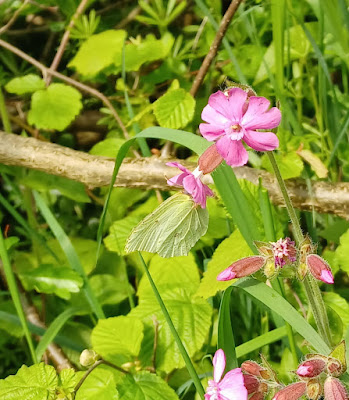News about seasonal changes at Filnore Woods and how to get involved as a volunteer, if you want to. As well as things seen and done at FILNORE WOODS, THE BLOG WILL INCLUDE THINGS YOU CAN SEE IN YOUR STREET OR GARDEN. To get regular updates, you used to be able to enter your email address in "FOLLOW BY EMAIL" (just below on the right) But this seems to have stopped working so GOOGLE 'FILNORE WOODS BLOG' AND FOLLOW 'FILNORE WOODS' ON FACEBOOK
Tuesday 31 May 2022
CINNABAR
Monday 30 May 2022
BURDOCKS BY THE HEDGE
Sunday 29 May 2022
SWIFTS AND MARTINS
On 10th May I first heard and saw swifts flying over the High Street. They are the ones with very long wings and screaming voices. They usually nest under the eaves of the Age UK office on the corner of Chapel Street, opposite the window I look out of from my computer desk. Two of them flew up to the usual nesting site on that day. The swifts have flown over on a couple more occasions but now they seem to have gone. I hope the entrance to their nest site was not blocked up during recent redecoration of the exterior.
House Martins chirrup and have white tummies and rumps whereas Swifts scream and are very dark brown all over.
Swallows tend to be more rural as they build their nests inside open sheds or stables. So we don't have them in town. They twitter.
Saturday 28 May 2022
Friday 27 May 2022
WEEVIL
A cracking shot of a pale green WEEVIL on the newish leaflet dispenser at Filnore Woods.
Weevils are vegetarian so don't usually eat leaflets.
Thursday 26 May 2022
PIGNUT ETC
Wednesday 25 May 2022
ALLAN BURBERRY TREE
The fern-leaved beech tree planted for the late Allan Burberry last November has come into leaf at last and started growing.
Monday 23 May 2022
Sunday 22 May 2022
GREEN TIGER BEETLE
Saturday 21 May 2022
15: IVY-LEAVED TOADFLAX
Thursday 19 May 2022
BUTTERFLIES
Some butterflies recently captured on camera by Alan Watts.
The Speckled Wood can often be seen sunbathing on a leaf or flitting about busily in dappled shade.
Wednesday 18 May 2022
COMMON VETCH

Common Vetch (Vicia sativa) is one of the first of the pea family to flower. The purply-pink flowers are in pairs at the base of the leaves. The leaves are pinnate with up to eight pairs of leaflets (six pairs in this specimen). Each leaflet may be notched at the tip, with a little whisker. In the image below the shape of the leaflets is clear although some of them have been nibbled a bit by weevils.
The plant scrambles up other plants using the tendrils at the end of each leaf to grip.
As you can see, the tendrils are branched, with up to five little wires waiting to spiral round whatever they touch.
Monday 16 May 2022
ZOOMING POND FLIES
Friday 13 May 2022
FOXICIDE
Thursday 12 May 2022
16: STORKSBILL
Wednesday 11 May 2022
13: COWSLIP
Monday 9 May 2022
STEP BY STEP
Sunday 8 May 2022
MUNTJAC
Of course they escaped and have spread rapidly until they are now a species of concern. They like to browse woodland shrubs and ground flora so that they have seriously wiped out a lot of rare oxlips in their stronghold in woods in East Anglia and may have contributed to the decline of nightingales who like dense woodland understoreys.
Here is a recording of Muntjac calls by Steve Wilson, found on the British Deer Society website.
Muntjac are gravy coloured with lighter underparts. The males (bucks) have small antlers and 'tusks' and a dark v-shaped mark on their foreheads. Females (does) have no antlers and a diamond-shaped head mark. A muntjac doe can breed at 7 months and when she has given birth to her single fawn can mate again a few days later. They breed all the year round. This means they are now the most common deer in Britain.
Some people think they are cute. I think, "Eat More Venison".
Deer of all species have no natural predators and are eating our countryside away.

















































